
Creating a healthier, more connected workplace starts with bringing teams together through shared physical activities. At Matter, we understand that building strong teams requires more than just collaborative projects and meetings. Team workout challenges provide a unique opportunity to boost morale, enhance health, and foster stronger relationships while having fun. These fitness challenges foster lasting bonds as colleagues support one another through physical goals, celebrate achievements, and discover new ways to stay active together
The modern workplace faces increasing demands for employee wellness programs that engage participants and deliver measurable results. Regardless of whether each member of your team works in an office setting, from home, or in a hybrid situation environment, implementing structured fitness challenges can transform workplace culture while addressing health concerns and building community. This comprehensive guide provides 49+ innovative challenge ideas designed to inspire participation, accommodate all fitness levels, and create positive momentum that extends far beyond the gym challenge environment.
Why are team workout challenges essential for workplace success?
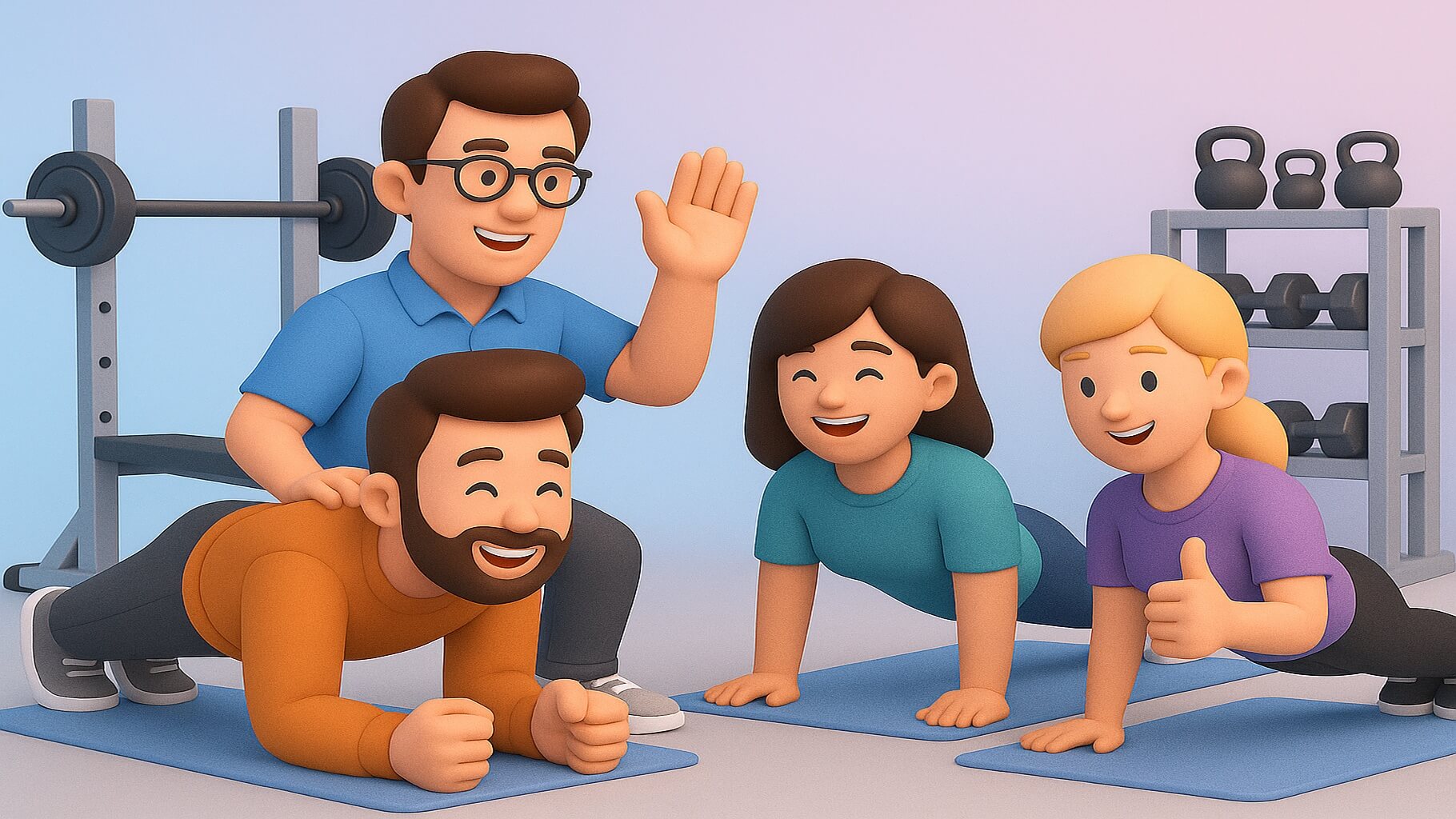
Team workout challenges have evolved from simple step competitions to comprehensive wellness programs that address physical health, mental well-being, and organizational culture. When employees participate in group fitness activities, they develop stronger connections with colleagues while improving their overall health and potential for weight loss. These programs create opportunities for friendly competition, mutual support, and shared accomplishments that lead to improved workplace dynamics.
Research clearly demonstrates that organizations investing in employee fitness challenges see improvements in productivity, reduced healthcare costs, and higher retention rates. The combination of physical activity and team building creates a powerful synergy that benefits both individuals and organizations. By implementing well-designed workout challenges, companies demonstrate their commitment to employee well-being while fostering an environment where healthy habits thrive and regular physical activity becomes the norm.
The power of team exercise challenges for bonding
Team exercise challenges create unique bonding opportunities that traditional team-building challenges often miss. When colleagues work together toward fitness goals, they share vulnerabilities, celebrate progress, and develop mutual respect that strengthens professional relationships. Overcoming physical obstacles together fosters friendship and trust that carries over into daily work interactions.
Benefits of exercise-based team bonding include:
- Breaking down hierarchical barriers, as every person participates equally
- Creating shared memories through fun team challenges that engage multiple muscle groups
- Developing empathy as team members support different fitness levels
- Building accountability partnerships that extend beyond workout challenges
- Establishing clear goals that unite diverse team members
How group fitness builds stronger work relationships
Group workouts transform colleague relationships by creating regular opportunities for positive interactions outside typical work contexts. When teams engage in fitness challenges together, they discover new aspects of each other's personalities, strengths, and determination. This deeper understanding fosters better communication, increased collaboration, and stronger professional networks within the organization, helping clients achieve their wellness objectives.
The social aspects of group fitness create lasting impacts on workplace culture:
- Regular workout sessions establish consistent touchpoints for team interaction
- Shared struggles during challenging exercises build mutual support systems
- Success celebrations reinforce positive team dynamics and help participants stay fit
- Fitness partnerships encourage ongoing communication and check-ins
- Group achievements boost collective confidence and morale while promoting weight loss goals
Measurable benefits of workplace fitness programs
Organizations implementing structured workplace fitness challenges report significant improvements across multiple metrics. These programs deliver quantifiable returns on investment through decreased healthcare expenses, higher productivity, and decreased absenteeism. There are health advantages that surpass mere physical enhancements to include enhanced mental well-being, reduced stress levels, and improved job satisfaction.
Key measurable outcomes from workplace fitness initiatives:
- Decreased sick days and healthcare utilization among clients
- Improved employee engagement scores and sense of community
- Higher retention rates among program participants
- Enhanced productivity metrics and focus during work hours
- Reduced workplace stress and burnout indicators
12 team fitness challenges at work for beginners
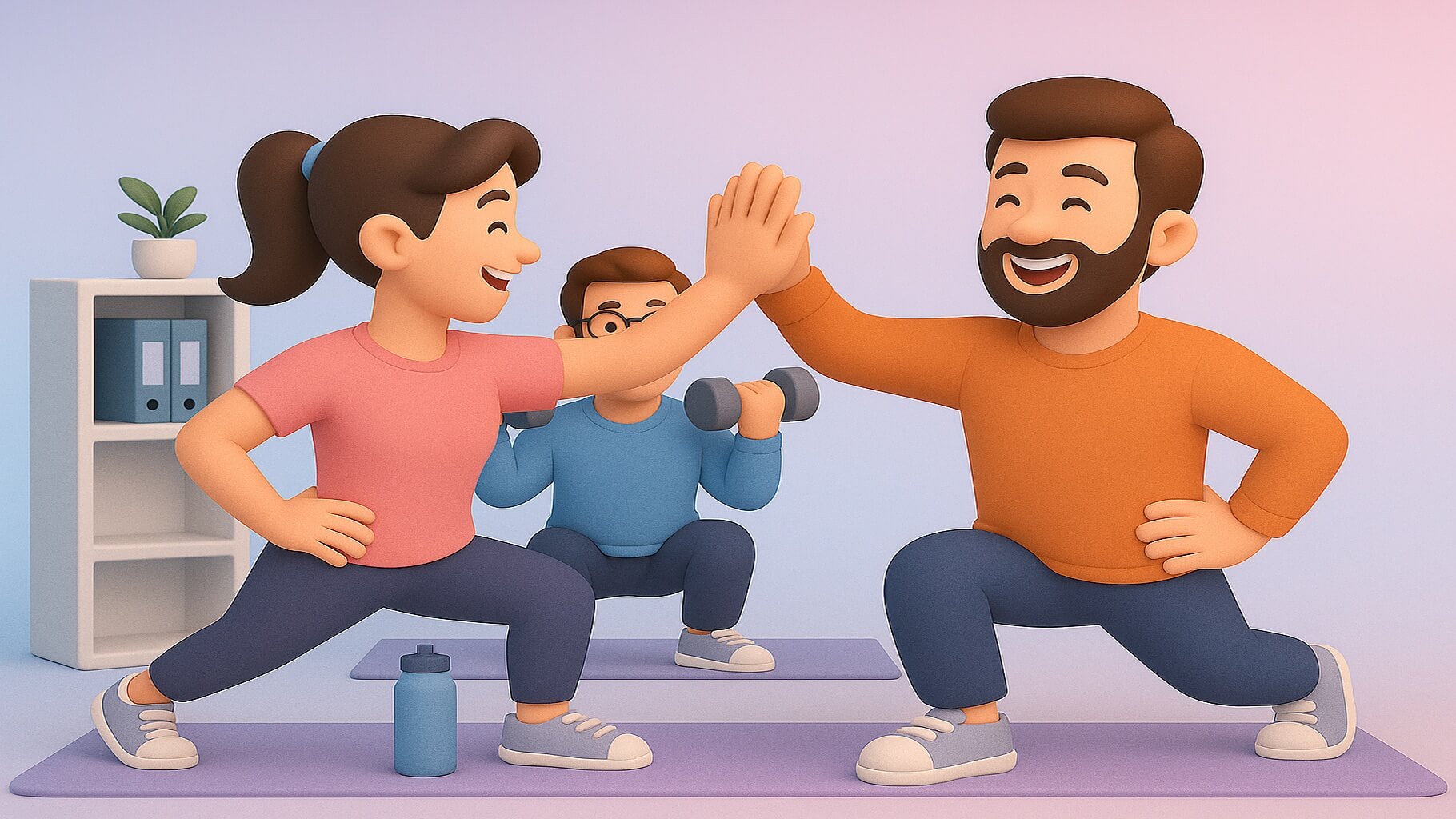
Starting a workplace fitness program requires inclusive challenge ideas that welcome participants at all fitness levels. These beginner-friendly options focus on building confidence, establishing healthy habits, and creating positive experiences that encourage continued participation. Each challenge emphasizes gradual progress and celebrates small victories to maintain motivation throughout the fitness journey.
12 beginner-friendly fitness challenge ideas:
- Daily steps challenge - Teams compete to reach collective step goals, starting at 5,000 steps per person and gradually increasing
- Water intake competition - Track daily hydration goals with teams supporting each other to maintain healthy habits and improve body function
- Desk stretch sessions - Five-minute guided stretching breaks every two hours to combat sedentary work styles
- Walking meetings - Replace traditional sit-down meetings with walking discussions around the building or neighborhood to increase daily steps
- Stair climbing goals - Start with one flight of stairs daily and progress to multiple climbs throughout the workday
- Lunchtime yoga - Gentle 20-minute sessions focusing on stress relief and flexibility improvement
- Morning meditation challenge - Begin workdays with five-minute guided mindfulness exercises
- Posture improvement program - Daily reminders and exercises to maintain proper alignment during work
- Weekend activity photos - Share images of weekend physical activities to inspire team participation
- Healthy snack swaps - Teams support nutrition goals by sharing healthy alternatives to common office snacks
- Stand-up desk intervals - Alternate between sitting and standing every 30 minutes to increase daily movement
- Team walking club - Organize regular group walks before work, during lunch, or after hours
Entry-level team fitness challenges at work
Creating accessible entry points for office fitness challenges ensures maximum participation and sustainable engagement. These programs focus on achievable goals that build confidence while laying the foundation for long-term, healthy habits. By starting with manageable objectives, teams develop momentum that naturally leads to increased physical activity and improved fitness levels. Even simple activities, such as sit-ups, can become engaging when incorporated into team competitions.
Successful entry-level challenges share common characteristics:
- Clear goals that feel attainable for beginners and prevent people from losing interest
- Flexible participation options accommodating various schedules
- Emphasis on effort rather than performance metrics
- Regular encouragement and positive reinforcement
- Gradual progression that prevents overwhelm or injury
Low-impact exercises for all fitness levels
Low-impact activities offer safe and effective options for team members with varying physical capabilities or health concerns. These exercises minimize stress on joints while delivering significant health benefits and opportunities for team building. By offering diverse, low-impact choices, such as modified push-up challenge variations, organizations ensure inclusive participation that respects individual limitations while promoting collective well-being.
Effective low-impact team activities include:
- Swimming or water aerobics sessions at local facilities
- Tai chi classes focus on balance and gentle movement
- Resistance band workouts are adaptable to different strength levels
- Chair exercises designed for limited mobility participants that still involve multiple muscle groups
- Gentle cycling on stationary bikes or outdoor paths
Building confidence through group movement
Group movement activities create supportive environments where participants feel comfortable exploring new challenges in employee wellness. The collective nature of these exercises reduces individual pressure while encouraging shared experiences. As team members witness each other's progress and improvement, they gain confidence in their abilities and feel motivated to continue their fitness journey.
Confidence-building strategies for group fitness:
- Partner exercises that emphasize teamwork over competition
- Progress tracking that celebrates individual improvements and helps participants lose weight gradually
- Skill-building workshops teaching proper exercise techniques
- Peer mentorship programs pairing experienced participants with new participants
- Recognition systems acknowledging effort and consistency
10 high-energy teamwork challenges
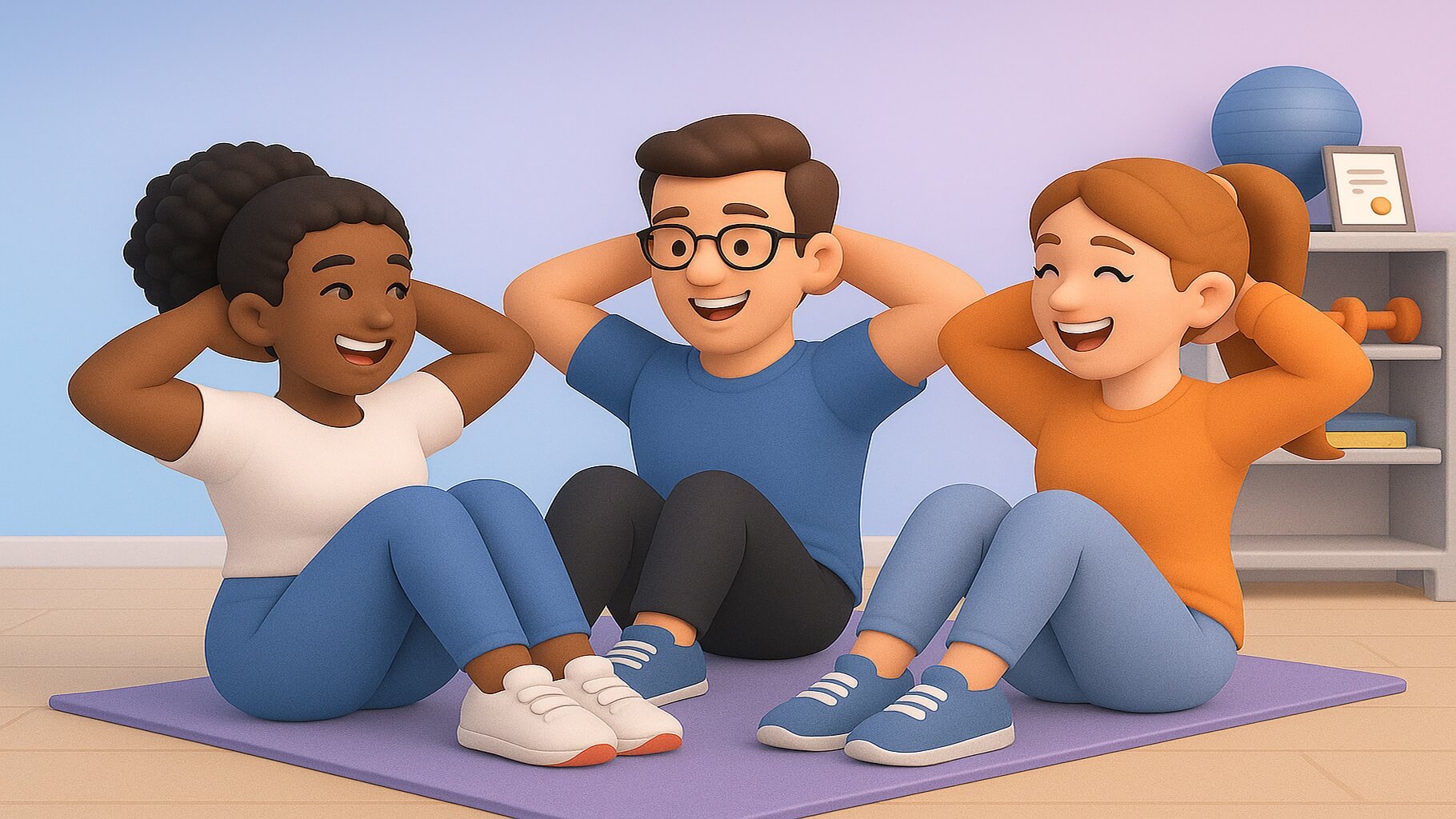
High-energy fitness challenges inject excitement and intensity into workplace wellness programs. These dynamic activities appeal to competitive team members while providing opportunities for significant fitness improvements and weight loss. By incorporating a variety of cardio exercise options and competitive elements, organizations create engaging programs that foster long-term participation and deliver impressive results for clients seeking measurable outcomes.
10 intense work challenges:
- HIIT circuit competitions - Teams rotate through high-intensity stations, including burpees, mountain climbers, and jump squats
- Sprint relay races - Outdoor events combining speed work with team strategy and coordination
- Boxing fitness classes - High-energy sessions incorporating punching combinations and footwork drills that involve the entire body
- Dance fitness battles - Choreographed routines that combine cardio exercise with creative expression
- Obstacle course challenges - Timed events requiring strength, agility, and team problem-solving throughout multiple stations
- Rowing machine competitions - Distance or time-based challenges using gym equipment
- Spin class tournaments - Virtual cycling competitions tracking distance and calories burned to support weight loss goals
- CrossFit-style workouts - Modified WODs (Workout of the Day) adapted for team participation and different fitness levels
- Basketball or volleyball tournaments - Traditional sports adapted for fitness challenge formats
- Adventure races - Multi-discipline events combining running, cycling, and strength challenges
Cardio-based teamwork challenges that excite
Cardiovascular fitness challenges create an energetic atmosphere that boosts team morale while improving heart health. These activities naturally generate excitement through movement, music, and friendly competition. By designing cardio challenges that feel more like games than exercise, organizations increase participation rates and create memorable experiences that strengthen team bonds while promoting weight loss.
Engaging cardio challenge formats:
- Musical workout stations rotate activities with song changes
- Theme-based cardio sessions inspired by popular movies or decades
- Progressive distance challenges track cumulative team achievements
- Heart rate zone competitions using fitness trackers for tracking progress
- Synchronized group activities create visual team unity
Competitive fitness games for motivated teams
Competition drives engagement for many participants, making game-based office exercise challenges particularly effective for motivated teams. These activities channel competitive spirits into positive outcomes while maintaining inclusive environments where effort matters more than winning. Well-designed competitive challenges strike a balance between individual achievement and team success, ensuring that each person feels valued, regardless of their fitness level.
Elements of successful competitive fitness games:
- Clear rules ensuring fair play across different abilities
- Multiple ways to contribute beyond pure athletic performance
- Team handicapping systems create balanced competitions
- Recognition for improvement percentages rather than absolute performance
- Rotating team compositions prevents dominant groups
HIIT workouts adapted for groups
High-Intensity Interval Training offers efficient and effective workouts, making it perfect for busy professionals. Group HIIT sessions create energy through synchronized efforts and mutual encouragement. These workout challenges deliver maximum results in minimal time while building team cohesion through shared intensity and recovery periods. Incorporating weight training intervals adds variety and helps participants lose fat while building strength.
Group HIIT adaptation strategies:
- Station rotations allow different fitness levels to work simultaneously
- Partner exercises incorporating teamwork into interval training
- Scaled options for each exercise accommodate various abilities
- Group countdowns create a unified effort and energy
- Cool-down periods emphasizing team recovery and support
9 creative work team fitness challenge ideas
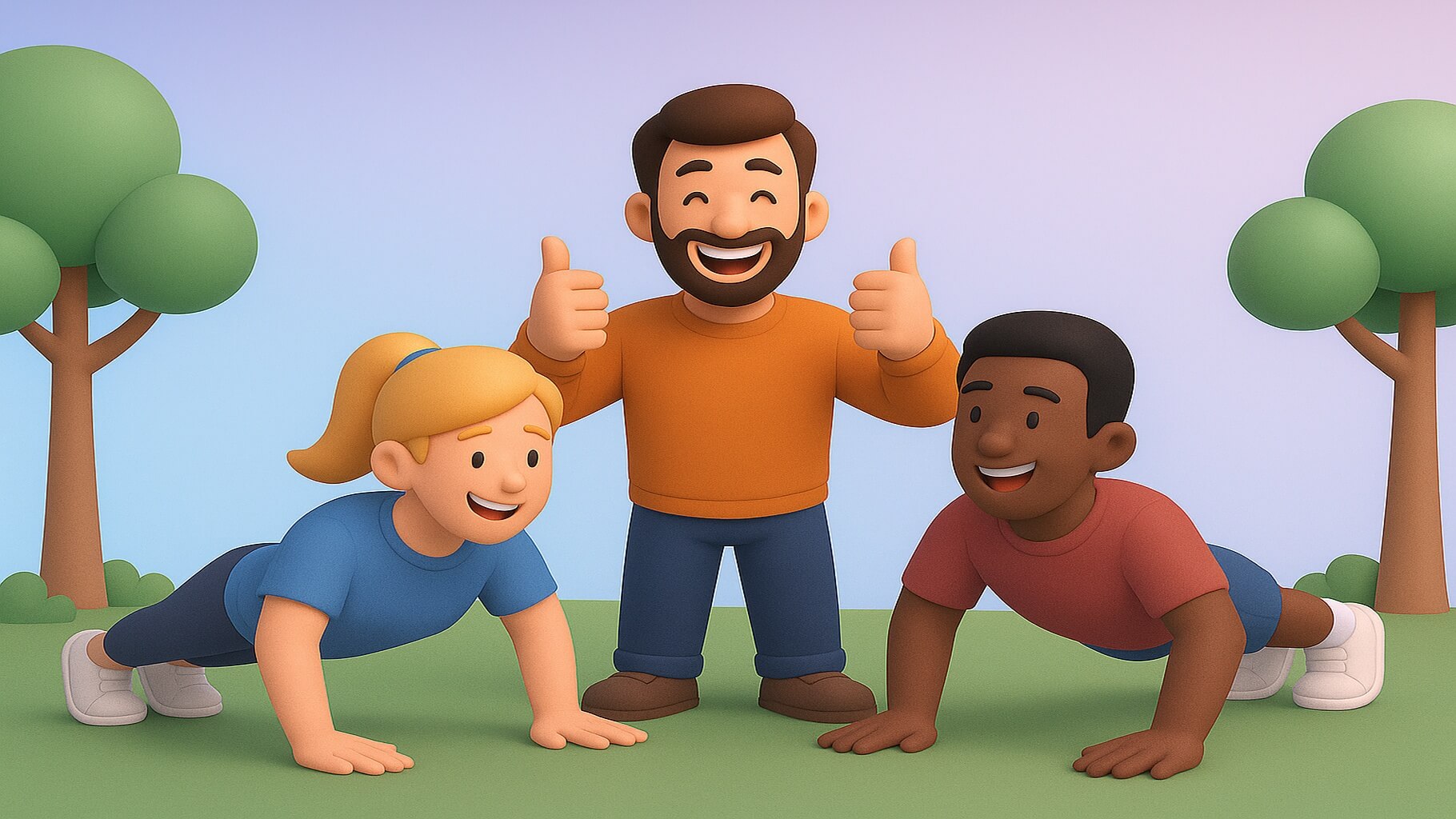
Innovation in fitness challenges keeps programs fresh and engaging throughout the year. Creative approaches to team workout challenges prevent monotony while appealing to diverse interests and personalities. These unique challenge ideas combine physical activity with elements of creativity, strategy, and fun, making exercise feel less like work and more like play, especially during the holiday season when people typically lose motivation.
9 innovative work team fitness challenge ideas:
- Fitness scavenger hunts - Teams complete exercise stations while solving clues around the workplace
- Virtual reality fitness experiences - Use VR technology for immersive group workout adventures
- Charity mile challenges - Convert team miles into donations for chosen causes
- Fitness bingo cards - Complete various activities, including sit-ups and push-up challenge stations, to achieve winning patterns
- Photo challenge workouts - Document creative exercise locations and positions
- Recipe and workout pairings - Combine healthy cooking competitions with related exercises focusing on nutrition
- Decades-themed fitness weeks - Workouts inspired by exercise trends from different eras
- Skills-based challenges - Learn new activities like juggling or hula hooping together
- Workplace Olympics - Multi-event competitions with opening ceremonies and team uniforms
Unique work team fitness challenge ideas
Standing out from typical fitness programs requires innovative thinking and a readiness to attempt novel strategies. Unique challenges capture attention, generate buzz, and create talking points that extend program reach. By incorporating unexpected elements into fun office challenges, organizations demonstrate innovation while making wellness programs memorable and shareable for all clients involved.
Characteristics of unique fitness challenges:
- Unexpected combinations of activities and themes
- Integration with company culture or industry themes that involve strategic planning
- Storytelling elements create narrative arcs
- Technology integration enhances traditional exercises
- Cultural celebrations incorporating global fitness traditions
Department vs. department competitions
Inter-departmental competitions leverage existing team structures and natural rivalries to boost participation. These team challenges create opportunities for departments to unite behind common goals while fostering healthy competition across organizational boundaries. Well-structured department challenges build company-wide engagement while respecting team dynamics and maintaining positive relationships.
Successful department competition strategies:
- Rotating challenge types, highlighting different departmental strengths
- Collaborative elements requiring cross-department cooperation
- Recognition systems celebrate both winning and participating departments
- Mixed team events prevent isolation between departments
- Leadership involvement in modeling healthy competition
Monthly themes that keep teams engaged
Themed monthly challenges maintain long-term engagement by providing variety and anticipation. Each month brings new opportunities to explore different aspects of fitness while preventing program staleness. Themes create cohesive experiences that unite various activities under compelling narratives, making participation feel fresh and exciting throughout the year, including special holiday season programs.
Engaging monthly theme examples:
- January "New Year, New You," focusing on goal setting and habit formation with clear goals
- March Madness basketball-inspired challenges and tournaments
- Summer Olympics preparation with international fitness traditions
- October "Scare Away the Pounds" Halloween-themed activities
- December "Maintain Don't Gain" holiday season strategies to prevent weight gain
8 group workout challenges for different spaces
Workspace limitations shouldn't prevent effective fitness challenges. These adaptable programs are effective in various environments, ranging from cramped offices to expansive outdoor areas. By designing office challenges that flex to available spaces, organizations ensure consistent participation regardless of physical constraints or weather conditions.
8 space-flexible group workout challenges:
- Conference room circuit training - Use meeting spaces for bodyweight exercises, including sit-ups and resistance band workouts
- Parking lot boot camps - Transform empty parking spaces into outdoor gym areas for group workouts
- Virtual team workouts - Synchronized home workouts via video conferencing
- Rooftop yoga sessions - Utilize outdoor building spaces for mindful movement
- Hallway walking challenges - Create measured routes through office corridors to increase daily steps
- Park meetups - Organize activities in nearby public green spaces
- Stairwell strength training - Use the building stairs for cardio and strength exercises targeting multiple muscle groups
- Lunch hour gym partnerships - Coordinate group visits to nearby fitness facilities
Office-friendly group workout challenges
Limited office space requires creative solutions for effective office wellness challenges. These activities maximize small areas while minimizing disruption to the work environment. Office-friendly challenges prove that meaningful exercise doesn't require extensive equipment or dedicated fitness facilities, making wellness accessible throughout the workday and helping employees stay fit.
Office workout considerations include:
- Noise levels respecting neighboring workspaces
- Professional attire adaptations for exercise
- Equipment storage in limited spaces
- Quick transition times between work and workouts
- Hygiene facilities for post-exercise needs
Outdoor team fitness activities
Outdoor environments offer natural settings for team fitness challenges, combining fresh air with physical activity. These activities capitalize on seasonal opportunities while offering variety from indoor routines. Outdoor challenges often feel less like structured exercise and more like recreational activities, increasing participation among reluctant fitness participants who might otherwise lose interest.
Benefits of outdoor fitness challenges:
- Natural vitamin D exposure improves mood and health
- Varied terrain provides workout diversity
- Seasonal activities maintain year-round interest
- Larger spaces accommodating bigger group activities
- Connection with nature reduces stress levels and promotes a sense of well-being
Virtual workout challenges for remote teams
Remote work doesn't eliminate opportunities for remote team challenges. Virtual platforms enable distributed teams to participate in synchronized workouts, maintaining connection despite physical distance. These digital fitness solutions create inclusive environments where location doesn't determine participation, ensuring all team members can engage in wellness initiatives and home workouts.
Virtual challenge success factors:
- Technology platforms supporting group video sessions
- Time zone considerations for global teams
- Home equipment alternatives for standard gym exercises
- Recording options for asynchronous participation
- Digital tracking systems monitor progress and improvement
7 fun group fitness challenges that build culture
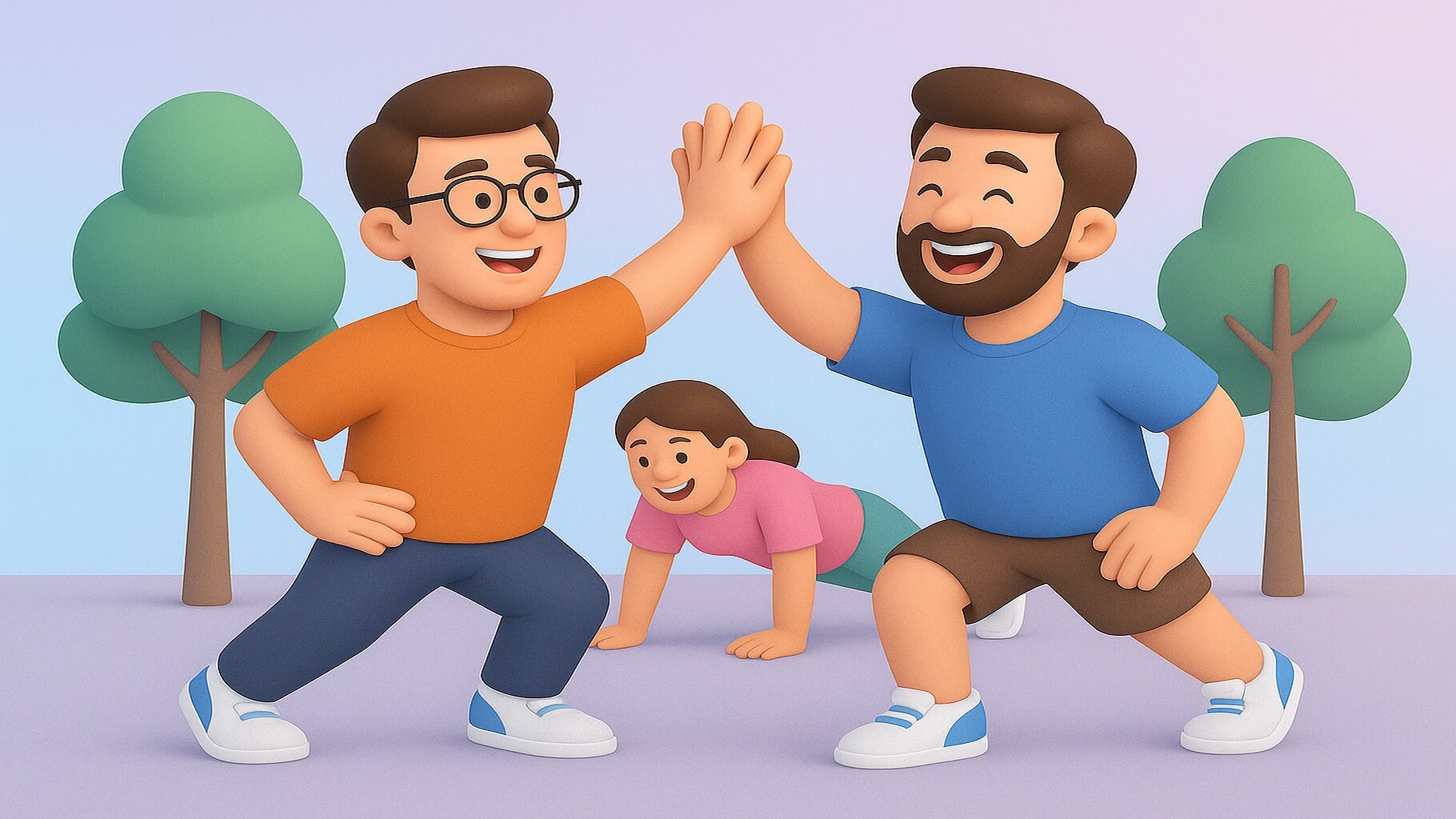
Culture-building fitness challenges extend beyond physical health to strengthen an organization's identity and values. These activities create shared experiences that become part of the company's lore, while reinforcing the desired cultural attributes. Fun challenges foster positive associations with workplace wellness initiatives, making fitness an integral part of the organizational culture rather than an add-on program.
7 culture-enhancing fun group fitness challenges:
- Costume workout days - Theme-based sessions where teams exercise in coordinated outfits
- Music video recreations - Learn and perform dance routines from popular songs
- Fitness flash mobs - Surprise synchronized exercises in unexpected locations
- Cultural dance workshops - Explore international movement traditions monthly
- Comedy workout sessions - Incorporate humor and laughter into exercise routines
- Pet-friendly fitness walks - Include furry friends in outdoor team activities
- Celebration workouts - Special sessions honoring achievements and milestones
Themed fun group fitness challenges
Themed challenges transform routine exercises into memorable events that participants anticipate and discuss. These creative approaches make fitness feel like a special occasion rather than an obligation. By aligning themes with company values, seasons, or popular culture, organizations create engaging experiences that resonate with diverse team members and help them lose themselves in the fun.
Successful theme implementation strategies:
- Advanced communication builds anticipation
- Optional costume or prop elements enhancing participation
- Music playlists supporting theme atmospheres
- Decorations transforming workout spaces
- Photo opportunities capturing memorable moments
Music-based movement activities
Music naturally motivates movement, making it a powerful tool for engaging fitness challenges. These activities leverage rhythm and melody to create energetic environments where exercise feels effortless. Music-based challenges cater to diverse preferences, offering soundtracks that enhance workout intensity and enjoyment, thereby helping participants stay engaged throughout their fitness journey.
Music integration techniques include:
- Playlist competitions where teams create workout soundtracks
- Rhythm-based exercises synchronize movement with beats
- Musical chairs variations incorporating fitness moves
- Karaoke spinning sessions combine singing with cycling
- Era-specific workouts featuring decade-appropriate music
Cultural fitness celebrations
Incorporating diverse cultural traditions into fitness challenges creates inclusive environments that celebrate organizational diversity. These activities educate participants about global wellness practices while providing unique exercise experiences. Cultural celebrations demonstrate respect for different backgrounds while uniting teams through shared physical activities that involve various approaches to health and nutrition.
Cultural fitness integration examples:
- Martial arts workshops exploring different disciplines
- Traditional dance classes from various cultures
- International sports tournaments featuring global games
- Wellness practices from different philosophical traditions
- Holiday-specific activities honoring various celebrations
5 team exercise challenges for quick breaks
Quick break challenges fit seamlessly into busy workdays, providing energy boosts without significant time investments. These micro-workouts combat sedentary behavior while offering mental refreshment between tasks. Short-duration challenges prove that effective exercise doesn't require hour-long gym sessions, making fitness accessible for time-pressed professionals who want to maintain regular physical activity.
5 efficient team exercise challenges:
- Two-minute plank challenge - Daily planking sessions with progressive hold times
- Desk push-up challenge - Quick strength sets using desk edges
- Wall sit competitions - One-minute challenges between meetings, working multiple muscle groups
- Breathing exercises - Synchronized deep breathing for stress relief
- Quick cardio bursts - Thirty-second high-intensity movements hourly
5-minute team exercise challenges
Five-minute challenges provide perfect solutions for teams seeking fitness benefits without major schedule disruptions. These brief sessions deliver surprising results when performed consistently, proving that small efforts compound into significant improvements. Quick challenges also serve as gateway activities, encouraging participants to gradually increase their fitness commitments and explore other challenges.
Effective 5-minute workout components:
- Warm-up movements prevent injury during brief sessions
- High-intensity exercises maximize limited time
- Cool-down stretches maintain flexibility
- Rotation systems ensure variety
- Progress tracking and documenting cumulative benefits
Lunchtime fitness bursts
Lunch hours offer ideal opportunities for fitness challenges that energize afternoons without exhausting participants. These midday activities combat post-lunch energy dips while providing social alternatives to desk dining. Lunchtime challenges create natural boundaries, ensuring workouts don't extend beyond available time while maximizing break periods for weight training or cardio exercise.
Lunchtime fitness strategies include:
- 20-minute sessions allowing time for changing and eating
- Low-sweat options respecting afternoon work requirements
- Outdoor walks utilizing weather opportunities to stay active
- Guided meditation sessions for mental fitness
- Nutrition workshops paired with movement activities
End-of-meeting energizers
Concluding meetings with brief physical activities improves energy levels and information retention. These energizers transition teams from sedentary discussions to active states, preparing them for subsequent tasks. End-of-meeting challenges also create positive associations with meetings, making them feel less draining and more energizing while helping participants maintain their fitness goals.
Meeting energizer benefits:
- Improved circulation enhances mental clarity
- Team bonding through shared movement
- Stress relief after challenging discussions
- Physical markers separating meeting segments
- Increased alertness for post-meeting productivity
How to implement successful team workout challenges
Successful implementation requires thoughtful planning that addresses the diverse needs, abilities, and preferences within teams. Organizations must strike a balance between challenge and accessibility, ensuring that programs inspire rather than intimidate potential participants. Strategic implementation fosters sustainable fitness cultures, where incorporating well-being into the organizational DNA becomes essential, rather than temporary initiatives that people quickly lose interest in.
Effective fitness challenge implementation follows structured approaches that consider multiple factors affecting participation and success. From initial planning through ongoing evaluation, each phase requires attention to detail and commitment to inclusive design. Organizations investing time in proper implementation see higher participation rates, better outcomes, and lasting cultural changes among their clients.
Choosing inclusive fitness activities
Inclusive design ensures that all team members can participate meaningfully in employee engagement challenges, regardless of their physical abilities, fitness levels, or health conditions. Selection processes must consider diverse needs while creating opportunities for everyone to contribute and succeed. Inclusive activities foster stronger teams by demonstrating an organizational commitment to the well-being and sense of belonging of every member.
Inclusive activity selection criteria:
- Multiple difficulty levels within the same activities
- Alternative exercises for common limitations
- Non-physical contribution options for team challenges
- Adaptive equipment accommodating different abilities
- Cultural sensitivity in activity choices
Tracking progress and celebrating wins
Progress tracking motivates while generating data for program improvement. Effective tracking systems strike a balance between comprehensive monitoring and user-friendly interfaces that don't create barriers to participation. Celebration strategies recognize both individual achievements and team accomplishments, creating positive reinforcement cycles that maintain engagement and help participants achieve their goals.
Tracking and celebration best practices:
- Digital platforms simplify data entry
- Visual progress displays motivating continued effort
- Regular milestone recognition maintains momentum
- Peer acknowledgment systems build community
- Reward structures valuing participation over performance
Safety considerations for workplace fitness
Safety protocols protect participants while reducing organizational liability. Comprehensive safety planning addresses physical risks, medical considerations, and environmental hazards. Well-designed safety measures enable confident participation without creating excessive barriers or diminishing the enjoyment of fitness activities.
Essential safety elements include:
- Medical clearance processes for high-risk participants
- Proper warm-up and cool-down protocols for every workout
- Equipment inspection and maintenance schedules
- Emergency response procedures and communication
- Insurance considerations for workplace fitness activities
How Matter elevates team workout challenges
Matter transforms team workout challenges from simple fitness activities into comprehensive engagement experiences. By integrating recognition, rewards, and tracking capabilities, Matter helps organizations maximize the impact of their wellness initiatives. The platform's seamless integration with existing workplace tools ensures that fitness recognition becomes an integral part of daily workflows, rather than an additional administrative burden for busy teams.
Organizations using Matter for fitness challenges report higher participation rates, sustained engagement, and stronger connections between wellness activities and overall employee satisfaction. The platform's flexibility accommodates various challenge types while providing consistent frameworks for recognition and rewards. This systematic approach to fitness recognition creates lasting behavior changes that benefit both individuals and organizations seeking to promote healthy lifestyles.
Recognition for fitness achievements
Matter's recognition features celebrate fitness milestones in meaningful ways that motivate continued participation. The platform enables peer-to-peer recognition for fitness achievements, creating supportive environments where colleagues acknowledge each other's efforts. This social recognition proves particularly powerful for sustaining long-term engagement in wellness programs and helping employees maintain their commitment to staying fit.
Recognition features supporting fitness challenges:
- Custom kudos cards celebrating specific fitness achievements
- Automated milestone recognition for consistent participation
- Team achievement acknowledgments fostering collective pride
- Integration with fitness tracking apps for seamless updates
- Public recognition feeds inspiring friendly competition
Team leaderboards and motivation
Leaderboards create visible progress tracking that motivates teams through friendly competition and collective achievement. Matter's leaderboard functionality strikes a balance between individual recognition and team accomplishments, ensuring everyone feels valued, regardless of their fitness level. Dynamic leaderboards adapt to different challenge types, maintaining relevance across various fitness activities and helping teams track their improvement over time.
Leaderboard features driving engagement:
- Real-time updates maintain competitive excitement
- Multiple ranking categories recognizing diverse achievements
- Team aggregation encourages collective efforts
- Historical tracking showing long-term progress
- Customizable metrics aligning with specific challenge goals
Reward systems for consistent participation
Matter's reward systems incentivize sustained participation through meaningful recognition rather than costly prizes. The platform's coin-based system resets weekly, encouraging authentic and consistent recognition that fosters positive habits. This approach proves more effective than one-time rewards, as it creates ongoing motivation for fitness participation and helps clients achieve lasting results.
Reward system benefits include:
- Flexible redemption options appeal to diverse preferences
- Team-based rewards encourage collective participation
- Milestone rewards recognizing long-term commitment
- Integration with company values reinforces cultural alignment
- Automated distribution reduces the administrative burden
FAQs about team workout challenges
Understanding common questions helps organizations design better fitness challenges that address participant concerns and maximize engagement. These frequently asked questions reflect typical considerations when implementing workplace wellness programs. Clear answers guide both organizers and participants, ensuring smooth program execution.
Q: What are the best group workout challenges for beginners?
A: The best beginner challenges focus on achievable goals like daily steps, walking meetings, and gentle stretching sessions. Begin with activities that require no special equipment or fitness experience, such as simple sit-ups or basic bodyweight exercises. Gradually increase intensity as participants build confidence and fitness levels. Success comes from consistency rather than intensity, making simple challenges like stair climbing or lunchtime walks particularly effective for newcomers.
Q: How long should team fitness challenges at work last?
A: Optimal challenge duration varies between 4 and 8 weeks, providing enough time to establish habits without causing fatigue. Shorter challenges work well for specific goals or seasonal activities, such as holiday season programs. Longer programs should incorporate variety and include milestone celebrations to maintain engagement. Consider running multiple shorter challenges rather than extended single programs to maintain fresh enthusiasm and prevent participants from losing interest.
Q: Can remote teams participate in workout challenges?
A: Remote teams can participate through virtual team challenges, home workouts, and step challenges. Technology enables synchronized workouts via video platforms while fitness apps track individual progress. Create inclusive challenges that accommodate different time zones and home environments. Virtual participation often increases overall engagement by removing location barriers and allowing flexible scheduling.
Q: How do companies measure the success of workplace fitness challenges?
A: Companies measure success through multiple metrics, including participation rates, tracking progress via fitness apps, employee engagement surveys, and health outcome data. Successful programs show improvements in team building, reduced sick days, and increased productivity. Many organizations also track weight loss goals achieved, daily step averages, and overall fitness levels improvement among clients. Regular assessment helps refine future challenges and demonstrate ROI to leadership.
Q: What equipment or budget is needed for team workout challenges?
A: Most effective fitness challenges require minimal investment, focusing on bodyweight exercises like sit-ups, push-up challenge variations, and walking programs. Basic equipment, such as resistance bands or yoga mats, can enhance group workouts without significant expense. Many companies partner with local gyms for discounted rates or utilize free outdoor spaces. The key is designing challenges that involve creativity rather than relying on costly gym equipment, making wellness accessible to organizations of all sizes.
Q: How can organizations maintain momentum when people lose interest in fitness programs?
A: Preventing participant dropout requires variety in challenge types, regular recognition, and addressing common barriers. Rotate between different activities that target multiple muscle groups, incorporate nutrition education, and consistently celebrate small wins. Creating shorter 4-week challenges rather than lengthy programs helps maintain engagement. Matter's platform helps by automating recognition and rewards, making it easier to acknowledge progress and keep teams motivated throughout their fitness journey, both during regular periods and the holiday season.
Final thoughts on team workout challenges
Team workout challenges represent powerful tools for building healthier, more connected workplaces. These programs deliver benefits that extend far beyond physical fitness and weight loss, creating stronger teams, improving morale, and establishing cultures that value employee well-being. Success requires thoughtful planning, inclusive design, and sustained support, ensuring all team members can participate meaningfully in creating positive change.
The variety of challenge options available means every organization can find approaches that match their culture, resources, and goals. From simple walking challenges to complex fitness competitions incorporating gym challenge elements, the key lies in starting somewhere and building momentum through consistent effort and celebration. Regular evaluation and adaptation ensure programs remain fresh, relevant, and engaging for diverse team members seeking to improve their health.
Key takeaways for successful team fitness programs
Successful fitness programs share common elements regardless of specific activities or challenge formats. Clear communication establishes expectations while inclusive design ensures broad participation. Regular recognition maintains motivation as consistent tracking demonstrates progress toward established goals. Safety considerations protect participants while variety prevents boredom. Most importantly, a leadership support and participation model is desired to model desired behaviors throughout organizations, inspiring others to stay active and engaged.
Building sustainable fitness cultures requires patience, persistence, and willingness to adapt based on participant feedback. Begin with simple challenges, establishing a solid foundation before progressing to more complex programs that involve weight training or advanced cardio exercises. Celebrate small wins while working toward larger goals. Remember that regular minor activities lead to long-term changes rather than dramatic short-term efforts that lead to burnout.
Why recognition matters in workout challenges
Recognition transforms fitness challenges from individual pursuits into community experiences. When colleagues acknowledge each other's efforts, it creates supportive environments where everyone feels valued. This peer recognition proves particularly powerful for sustaining motivation during difficult periods and helping participants lose weight sustainably. Public acknowledgment of fitness achievements inspires others while building positive associations with healthy behaviors.
Matter's recognition platform amplifies these benefits by making acknowledgment easy, visible, and meaningful. The system's design encourages frequent, specific recognition that reinforces desired behaviors and celebrates improvement. By connecting fitness achievements to broader organizational values, recognition helps embed wellness into company culture. This systematic approach to recognition ensures that fitness challenges create lasting impacts beyond temporary health improvements.
Start your team fitness journey with Matter
Transform your workplace wellness initiatives with Matter's comprehensive recognition platform. Our tools make it easy to launch engaging fitness challenges, providing frameworks for sustained participation and meaningful recognition. Whether starting first-time programs or enhancing existing initiatives, Matter provides the structure and support needed for successful team workout challenges that deliver real results for your clients.
Ready to take your employee fitness strategy to the next level? Schedule a demo with a Matter expert today and discover how the right tools can help you recognize great work, boost engagement, and support long-term business success.
























